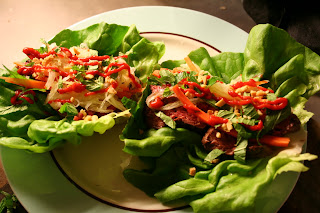Monday night. A pound of skirt steak from The Meat Hook has been thawing in the fridge for three days, since our original plan to grill it on Sunday fell through. It's a beautiful night, so we could definitely grill the steak tonight. But let's try for something a little more healthful, or at least something that seems a little more healthful. Maybe a salad, topped with grilled sliced skirt steak. That would be good. But it would be nice to do something with a little more flavor, something a bit more exotic…
A week prior, while babysitting for our friends Denis and Dana, we ordered Vietnamese sandwiches from Hanco's in Boerum Hill, our old neighborhood. It had been a while since we had them, and they really hit the spot.
The Vietnamese sandwich, or bánh mì, has been all the rage in New York lately, with shops popping up all around the city. The sandwich as I know it usually consists of pickled carrots and daikon radish, cucumbers, cilantro, chili peppers, pork pâté or ham, ground spiced pork, mayonnaise, and hot sauce (usually Huy Fong Sriracha sauce) on a baguette.
Though it probably only vaguely resembles traditional Vietnamese cooking, it captures that same interplay of spicy, sweet, tangy, salty, and savory flavors found so often in Asian cuisine, and it is delicious. And, I can attest, once you have one you tend to crave another one, and another one, and…
OK, back to the skirt steak. Our idea was to make a similar tasting dish using ingredients we had on hand. Even in NYC it's sometimes difficult to find that perfect baguette in the early evening on a weekday, so we decided to try and use lettuce as sort of a sandwich wrap to make what we've dubbed Vietnamese skirt steak lettuce wraps.
For the steak marinade, we just tried to throw together stuff from our fridge and pantry that seems to belong in Vietnamese food. We're no experts here, but it worked out pretty well. We would love to hear any suggestions as to how the marinade could be improved. Instead of steak for the filling, you could marinate thinly pounded chicken breasts or pork; or, you veggie heads could use tofu or mushrooms, and even fill it out with a little cooked rice.
Vietnamese skirt steak lettuce wraps
Ingredients:
1 lb. skirt steak
Marinade for steak (see below)
4-6 large leaves of Bibb or Boston lettuce
1 small carrot, julienned
½ cucumber, julienned
Handful of fresh mint, coarsely chopped
Crushed peanuts
Huy Fong Sriracha hot sauce
For marinade:
1 tsp. honey (or brown sugar)
1 tbsp. peanut butter (we used cashew butter)
½ shallot, roughly chopped
1 clove garlic, crushed
½ inch fresh ginger root, peeled and roughly chopped
½ tsp. fish sauce
1 tbsp. soy sauce
1 tbsp. rice vinegar
1 tbsp. rice vinegar
Chili paste or dried chili flakes to taste
Juice from ½ lime
¼ - ½ c. sesame oil (we ran out and used peanut oil instead. I think sesame would be better)
Place all marinade ingredients except oil in blender and puree. Put blender on low and slowly drizzle in oil until emulsified. Pour over skirt steak and let marinate for an hour or two at room temperature or, if you have the time, several hours or overnight in the fridge.
Heat grill to medium-high. If you don't have a grill, use a lightly oiled cast-iron skillet over the highest heat possible -- just be prepared for a lot of smoke! Grill skirt steak to desired doneness (medium rare please! Overcooked skirt steak is chewy and loses flavor). For medium rare, grill for about 4 minutes on each side. Remove from grill and let rest for 10 minutes.
Slice steak into pieces, cutting against the grain. To make wraps, put a piece of lettuce on your plate, toss on the steak, carrot, cucumber, mint, crushed peanuts, and as much hot sauce as you can bear. Pick the whole thing up like a taco and enjoy, making sure to dip into the accumulated steak juices/marinade on the plate.
The perfect food with which to try the first bottles of Ben's homebrewed pilsner!








